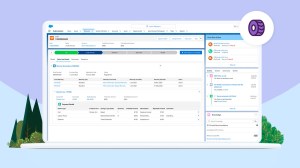Fast Innovation: How Salesforce Built a New Product In Eight Weeks to Help the World Reopen



Businesses today are under increasing pressure to find new ways to innovate quickly, while providing seamless user experiences and higher levels of security to accommodate the all-digital, work from anywhere world we’re in.
At Salesforce, we’ve responded to our customers’ needs faster than ever before. We launched Work.com in May to help organizations navigate the complexity of returning to the office safely. It included apps for manual contact tracing, employee wellness checks, shift scheduling, an employee learning platform and a command center to help leaders visualize the data and make informed decisions. And to meet the moment, we were able to build this entirely new suite of solutions in just eight weeks.
Now companies are starting to think about how they get back to growth. That’s why today, Salesforce announced a significant expansion of Work.com to include more than just safety and wellness, with a specific focus on employee productivity and trusted communications.
We sat down with Assaf Ben-Gur, VP of Product Management at Salesforce, to discuss how we’ve evolved Work.com to meet the needs of our customers – and how we were able to move fast with the Salesforce Platform.
Q. What new challenges are technology leaders facing?
Today businesses are expected to deliver new, all-digital, products and services at an unprecedented pace. We’ve seen this in the accelerated shift from retail stores to ecommerce channels, the rise of mobile ordering apps from restaurant chains, and in the huge boom in remote work technologies.
However, many of the technologies that CIOs, CTOs and IT teams have traditionally worked with aren’t well-suited for this new environment. When it comes to building and delivering new technologies, older platforms suffer from lengthy implementation times. These apps tend to be static in nature, and not built in a way that lends to fast, automated testing cycles. During a time when teams are trying to create cultural shifts around how fast work is delivered, outdated systems are hard to govern, which can introduce security and quality risks.
Q. How is the Salesforce Platform uniquely equipped to alleviate these challenges?
The Salesforce Platform enables organizations to innovate fast, and scale with confidence using low-code builders to empower everyone within an organization. The platform is effectively a set of building blocks that allow organizations to take pieces, combine them, and stack them together to build solutions and apps that best fit their unique business needs.
The platform comes with automation, privacy, security, mobile, AI and more built in, so organizations can instantly leverage low-code builders to ultimately delight every employee and customer with modern experiences that do not sacrifice enterprise quality – all without having to code. It’s defined by an open, standards-based developer experience that empowers development teams to build, test, and deploy new apps fast, from anywhere, and with the tools they prefer.
In short, the Salesforce Platform empowers anyone to drag, drop, and deliver modern apps – automating processes and allowing teams to release faster
Assaf Ben-Gur, VP Product Management, Salesforce
Q. How were you able to condense the Work.com release cycle into eight weeks?
At the beginning of the pandemic, our customers were looking to us for help create a pathway back to the office. And this wasn’t easy, because we weren’t in the office either! But to meet their expectations, with the power of the Salesforce Platform, we built, tested, and shipped an entirely new integrated suite of solutions in eight short weeks to bring the idea of Work.com to life.
Stay with me as I get technical to provide a look behind the scenes. To build, test and deliver Work.com, we used development environments like Scratch Orgs – a disposable deployment of Salesforce code – for every developer across our development teams. We paired this with a branching process that allowed us to build much faster, as well as continuous integration and delivery to ensure that what we did would be vetted for quality at every step.
Q. What challenges did you face when building Work.com?
We quickly realized we were going to have to build multiple related products to address different aspects of the return to work journey, and aligned on packaging as the best way to do this at scale. Thanks to our packaging capabilities, we were able to assemble apps for various return to work functions, such as shift management and wellness checks. And since our first launch in June, we’ve continued to deliver new features and apps on a monthly cadence.
This work took place across many different teams, and while the technology is critical, it wouldn’t have been feasible to move this quickly if the people and processes weren’t firmly in place. With the combination of our platform, people and processes, we were able to condense an effort that normally would have taken 6 months into 8 short weeks.
Q. What are you announcing with today’s expansion of Work.com?
In many of the same ways that business and operating models had to be flipped on their head to keep customers informed and businesses afloat, employee experience and support processes have to be transformed to meet the demands of the new normal.
That’s why today we announced an expansion of Work.com, with a specific focus on employee productivity and communications. New products include an employee workspace and helpdesk to boost productivity, and communication apps that inform customers and employees on new policies and procedures to foster safer in-person experiences.
This is the new Work.com – a full suite of products that includes apps for employee productivity, trusted communications, workplace safety, IT support and employee wellness. With work.com companies can get back to growth and thrive in the new normal.
Q. What did you take away from this experience?
We’ve all learned that no matter how large or stable your company may be, you will face disruption, and you’ll face it often.
Assaf Ben-Gur, VP Product Management, Salesforce
Work.com is strongly tied to Salesforce’s core belief that business can be the greatest platform for change. It’s a powerful example of how much value and impact we can bring to our customers, employees, communities and schools when they need it most. I’m extremely proud of the many teams across Salesforce who rallied on our mission to not only help organizations stabilize their businesses, but to help them quickly get back to growth and be prepared for the next crisis.
The world’s changing fast, but the Salesforce Platform can help our customers keep pace.















